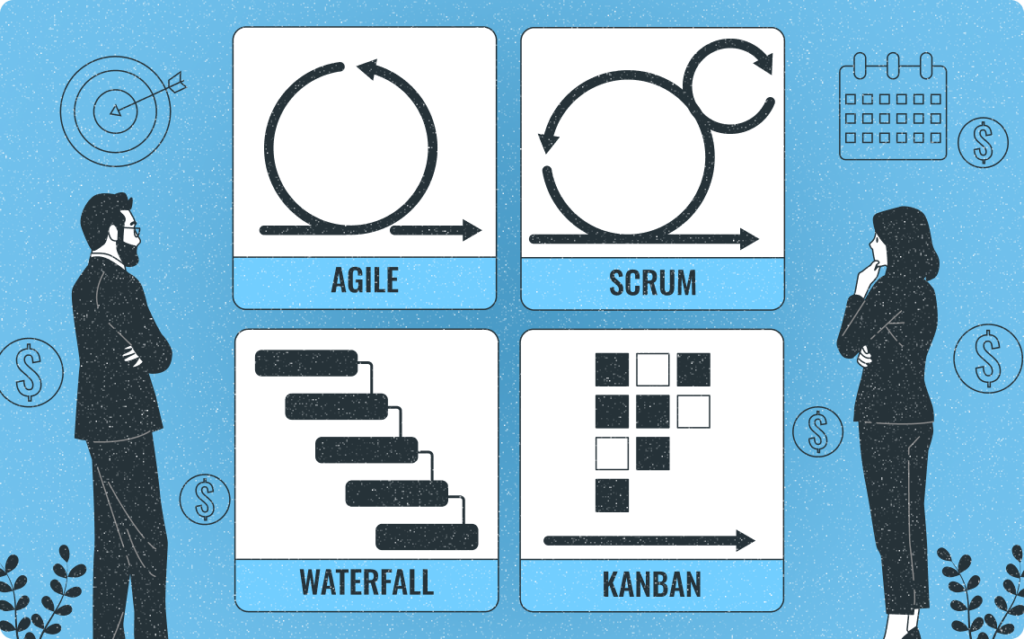Mastering Scrum Estimation: Techniques for Agile Teams

Understanding Scrum Estimation
The Importance of Accurate Estimation
Accurate estimation is crucial in Scrum as it helps in setting realistic expectations for the workload associated with completing user stories or tasks. By assigning relative size or time values to each task, the team can make informed decisions about their capacity and plan sprints more effectively. This process not only aids in better sprint planning but also enhances the predictability of project timelines.
Common Challenges in Estimation
Scrum effort estimations, in practice, can vary in accuracy due to several factors. One important factor is the level of experience and expertise of the team members involved in the estimation process. Estimations tend to improve over time as the team becomes more familiar with the project’s complexities. However, it is crucial to note that effort estimations are still prone to inaccuracies. Common challenges include:
- Unclear requirements: Ambiguities in user stories can lead to incorrect estimations.
- Changing scope: Frequent changes in project scope can disrupt initial estimations.
- Team dynamics: Variations in team collaboration and communication can affect estimation accuracy.
Role of Team Collaboration
Team collaboration plays a pivotal role in the accuracy of Scrum estimations. During the sprint planning meeting, the team discusses product backlog items and collectively estimates the effort required. This collaborative approach ensures that different perspectives are considered, leading to more balanced and realistic estimations. Key aspects of effective team collaboration include:
- Open communication: Encouraging team members to voice their opinions and concerns.
- Shared understanding: Ensuring that all team members have a common understanding of the tasks and goals.
- Iterative refinement: Continuously refining estimations based on feedback and historical data.

Popular Scrum Estimation Techniques
Planning Poker
Planning Poker is a consensus-based estimation technique that leverages the collective wisdom of the team. Each team member selects a card representing their estimate for a given task, and all cards are revealed simultaneously. This method encourages discussion and helps in reaching a more accurate estimate.
Story Points
Story Points are a unit of measure for expressing the overall effort required to implement a user story. This technique focuses on the relative complexity, risk, and effort of tasks rather than specific time durations. Teams often use a Fibonacci sequence to assign Story Points, which helps in differentiating between tasks of varying sizes.
T-Shirt Sizing
T-Shirt Sizing is a simple and intuitive estimation technique where tasks are categorized into different sizes, such as XS, S, M, L, and XL. This method is particularly useful for high-level estimations and provides a quick way to gauge the relative size of tasks without getting into detailed analysis.
| Technique | Best For | Key Benefit |
|---|---|---|
| Planning Poker | Team consensus and discussion | Encourages collaboration |
| Story Points | Relative complexity and effort | Focuses on overall effort |
| T-Shirt Sizing | High-level estimations | Quick and intuitive |
Selecting the right estimation technique depends on various factors, including the complexity of the project, the size of the team, and the specific needs of the organization. Each method has its own advantages and can be tailored to fit the unique requirements of the team.
Get more out of your business
Get the best employee engagement content every week via mailing list

Advanced Estimation Methods
Bucket System Estimation
This technique involves categorizing tasks into different ‘buckets’ based on their complexity and effort required. Each bucket represents a range of story points or effort hours. This method helps in quickly sorting tasks and is particularly useful for large backlogs.
Random Distribution
In this method, team members randomly assign estimates to tasks without prior discussion. The randomness helps in identifying outliers and encourages team discussions to reach a consensus. This technique can be a fun and engaging way to break the monotony of traditional estimation methods.
Ideal Days
Ideal Days estimation involves calculating the number of days a task would take if there were no interruptions or distractions. This method helps in understanding the pure effort required and can be adjusted for real-world factors like meetings and breaks. It provides a clear picture of the task’s complexity and required effort.
| Technique | Description | Best For |
|---|---|---|
| Bucket System Estimation | Categorizing tasks into effort-based buckets | Large backlogs |
| Random Distribution | Randomly assigning estimates to identify outliers | Team discussions |
| Ideal Days | Calculating effort in ideal conditions | Understanding task complexity |
These advanced methods offer diverse approaches to estimation, allowing teams to choose the one that best fits their workflow and project requirements.

Improving Estimation Accuracy
One effective way to refine estimations is by evaluating the accuracy of previous estimate forecasts. By comparing the original estimates with the actual effort expended on tasks, teams can identify areas where their estimations were off and learn from those situations. This continuous learning process, retrospective analysis, and refinement of estimation techniques can significantly improve accuracy over time.
Incorporating lessons learned from past projects is crucial for improving estimation accuracy. Techniques like Planning Poker or Affinity Estimation involve assigning numerical values or story points to tasks based on their relative sizing and uncertainty. Through this process, teams can collectively assess and refine their initial rough estimates by grouping similar tasks together according to complexity. Effective communication among team members ensures a shared understanding of requirements, contributing to better estimations.
Using historical data to inform future estimates is another powerful method. By analyzing past project data, teams can identify patterns and trends that can help in making more accurate predictions. For instance, if a team finds that their estimates are consistently within a range of +/- 10% of the actual effort expended, they can use this information to adjust their future estimates accordingly. Having clear requirements and well-defined user stories also plays a significant role in improving estimation accuracy.

Practical Tips for Effective Estimation
Breaking Down Complex Tasks
Breaking down complex tasks into smaller, more manageable pieces is essential for accurate estimation. This approach helps in identifying potential challenges early and allows for more precise effort estimates. Teams can use techniques like user story mapping or task decomposition to achieve this.
Encouraging Team Participation
Encouraging team participation in the estimation process ensures that all perspectives are considered, leading to more accurate and realistic estimates. Techniques such as Planning Poker or Affinity Estimation can facilitate this collaborative approach. The conversation that happens during these sessions is invaluable for understanding the work to be done.
Balancing Precision and Flexibility
Balancing precision and flexibility is crucial for effective estimation. While it’s important to strive for accurate estimates, it’s equally important to remain adaptable to changes. Teams should avoid going into too much detail or making assumptions during the estimation process. Instead, they should focus on iterative refinement and incorporate lessons learned from previous iterations.
| Tip | Description |
|---|---|
| Break Down Tasks | Divide complex tasks into smaller pieces for better accuracy. |
| Team Participation | Involve the entire team to gather diverse insights. |
| Balance Precision | Strive for accuracy but stay adaptable to changes. |

Case Studies and Real-World Examples
Real-world examples showcase successful implementation of agile estimation techniques across various industries such as software development, marketing campaigns, and product launches. Teams have reported improved accuracy in predicting timelines for project completion while fostering better communication among team members through these practices.
Lessons Learned from Failures
Understanding the pitfalls and challenges faced by teams during estimation can provide valuable insights. Common issues include underestimating complexity, lack of team collaboration, and failure to incorporate feedback. Learning from these failures helps in refining estimation techniques and improving overall project outcomes.
Adapting Techniques to Different Teams
The key is understanding when to utilize each technique based on the project’s needs and team dynamics. By being aware of their strengths and weaknesses, teams can adapt these methods to suit their specific requirements effectively. For instance, using Planning Poker for small, well-defined tasks and T-Shirt Sizing for larger, more ambiguous projects can lead to better estimation accuracy.
Conclusion
Mastering Scrum estimation is a pivotal skill for Agile teams aiming to enhance their planning and execution processes. By leveraging a variety of techniques such as Planning Poker, Story Points, and T-Shirt Sizing, teams can break down complex tasks into manageable units and achieve more accurate estimations. While no method guarantees absolute precision, the iterative nature of Scrum allows teams to continually refine their estimates and improve over time. Collaborative efforts involving all team members are essential for achieving consensus and enhancing the overall accuracy of estimations. Ultimately, effective Scrum estimation not only facilitates better planning and decision-making but also fosters a more cohesive and efficient team dynamic.
— The Monitask Team
Frequently Asked Questions
How accurate are Scrum effort estimations in practice?
The accuracy of Scrum effort estimations can vary. While they provide a useful framework for planning, the actual accuracy depends on the team’s experience, understanding of the tasks, and the complexity of the work. Over time, teams can improve their estimation accuracy through iterative refinement and feedback.
Is it possible to improve the accuracy of Scrum effort estimations over time?
Yes, it is possible to improve the accuracy of Scrum effort estimations over time. Teams can achieve this by incorporating feedback, leveraging historical data, and continuously refining their estimation processes.
Why is team collaboration important in Scrum estimation?
Team collaboration is crucial in Scrum estimation because it ensures that diverse perspectives are considered, leading to more accurate and realistic estimates. Collaborative estimation techniques like Planning Poker promote consensus and a shared understanding of the work involved.
What are some practical tips for effective Scrum estimation?
Some practical tips for effective Scrum estimation include breaking down complex tasks into smaller units, encouraging team participation, balancing precision and flexibility, and using historical data to inform estimates.
Can Scrum estimation techniques be adapted to different teams?
Yes, Scrum estimation techniques can be adapted to different teams. It’s important to consider the team’s specific context, experience level, and the nature of the work when selecting and adapting estimation methods.


